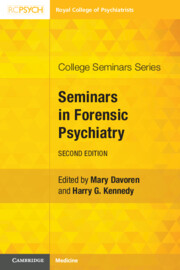Book contents
- Seminars in Forensic Psychiatry
- College Seminars Series
- Seminars in Forensic Psychiatry
- Copyright page
- Contents
- Contributors
- Foreword
- Introduction
- Chapter 1 Violence and Mental Disorder
- Chapter 2 Violence and Mental Disorder
- Chapter 3 Outcomes from the Key Inquiries and the Evolution of Modern Forensic Psychiatry
- Chapter 4 Prison Psychiatry
- Chapter 5 Legal Issues and Expertise in Forensic Psychiatry
- Chapter 6 Expertise, Structured Professional Judgement and Risk Assessment
- Chapter 7 Models of Care in Forensic Psychiatry
- Chapter 8 Psychopharmacology of Chronic Aggression and Violence in Forensic Settings
- Chapter 9 Ward Milieu and the Management of In-Patient Violence
- Chapter 10 Community Forensic Psychiatry Including Liaison with Health, Criminal Justice and Public Protection Agencies
- Chapter 11 Assessment of Personality Disorder, Psychopathy and Associated Offending Behaviour
- Chapter 12 Stalking and Threats to Harm and Kill
- Chapter 13 Sexual Offending
- Chapter 14 Terrorism-Related Assessments
- Chapter 15 Forensic Psychotherapy and Psychological Therapies in Forensic Mental Health Settings
- Chapter 16 Forensic Aspects of Medical Negligence
- Chapter 17 Child and Adolescent Forensic Mental Health Services
- Chapter 18 Women’s Services in Forensic Psychiatry
- Chapter 19 Forensic Psychiatry and Intellectual Disability
- Chapter 20 Cultural Service Delivery in Forensic Mental Health Services
- Chapter 21 Tackling Ethnic Inequality in Forensic Mental Healthcare
- Chapter 22 Academic Forensic Psychiatry
- Chapter 23 The No-Nonsense Guides
- Index
- References
Chapter 2 - Violence and Mental Disorder
Clinical Considerations
Published online by Cambridge University Press: aN Invalid Date NaN
- Seminars in Forensic Psychiatry
- College Seminars Series
- Seminars in Forensic Psychiatry
- Copyright page
- Contents
- Contributors
- Foreword
- Introduction
- Chapter 1 Violence and Mental Disorder
- Chapter 2 Violence and Mental Disorder
- Chapter 3 Outcomes from the Key Inquiries and the Evolution of Modern Forensic Psychiatry
- Chapter 4 Prison Psychiatry
- Chapter 5 Legal Issues and Expertise in Forensic Psychiatry
- Chapter 6 Expertise, Structured Professional Judgement and Risk Assessment
- Chapter 7 Models of Care in Forensic Psychiatry
- Chapter 8 Psychopharmacology of Chronic Aggression and Violence in Forensic Settings
- Chapter 9 Ward Milieu and the Management of In-Patient Violence
- Chapter 10 Community Forensic Psychiatry Including Liaison with Health, Criminal Justice and Public Protection Agencies
- Chapter 11 Assessment of Personality Disorder, Psychopathy and Associated Offending Behaviour
- Chapter 12 Stalking and Threats to Harm and Kill
- Chapter 13 Sexual Offending
- Chapter 14 Terrorism-Related Assessments
- Chapter 15 Forensic Psychotherapy and Psychological Therapies in Forensic Mental Health Settings
- Chapter 16 Forensic Aspects of Medical Negligence
- Chapter 17 Child and Adolescent Forensic Mental Health Services
- Chapter 18 Women’s Services in Forensic Psychiatry
- Chapter 19 Forensic Psychiatry and Intellectual Disability
- Chapter 20 Cultural Service Delivery in Forensic Mental Health Services
- Chapter 21 Tackling Ethnic Inequality in Forensic Mental Healthcare
- Chapter 22 Academic Forensic Psychiatry
- Chapter 23 The No-Nonsense Guides
- Index
- References
Summary
Violence is common and is a public health issue. Forensic psychiatrists offer treatment for the small amount of violence that is due to mental disorder. It is essential to distinguish between meaningful explanations and causes. Violence is not a unitary concept. Evidence for the specific causal associations between mental illness and violence is reviewed. Anger, anxiety, moral and amoral actions are reviewed including intoxication and withdrawal, deception, antisocial personality and psychopathy, and a range of mental illnesses and developmental disorders. Social and developmental factors are also important. Memes, media and social contagion influence the forms of violence. Court reports and treatments are considered critically in relation to violence.
- Type
- Chapter
- Information
- Seminars in Forensic Psychiatry , pp. 36 - 64Publisher: Cambridge University PressPrint publication year: 2024



